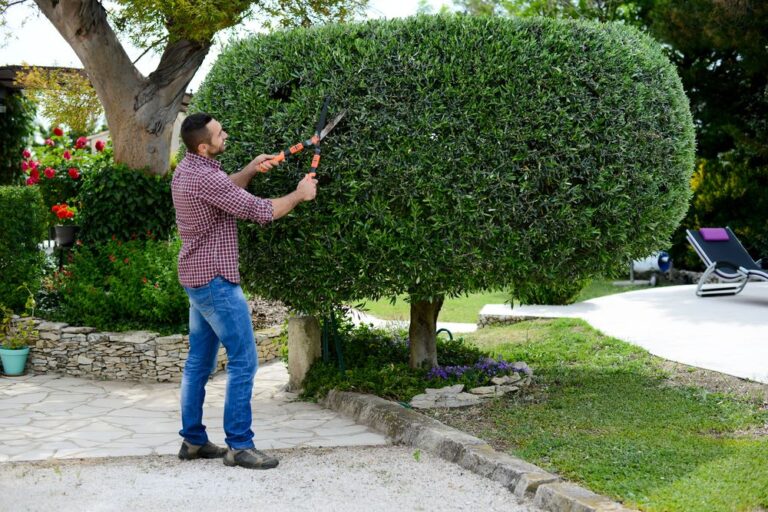Caring for trees involves more than just watering them. Trimming and pruning trees are essential for maintaining their structure, encouraging healthy growth, and preventing safety hazards. Proper tree care also helps trees fight off diseases, pests, and environmental stress. Whether you have trees in your backyard or manage a larger landscape, understanding the right way to care for them can make a significant difference.
The Importance of Proper Tree Care
Tree care calls for more than just watering. Maintaining their structure, promoting good development, and avoiding safety hazards all depend on trimming and pruning. Good tree care also helps trees fight environmental stress, pests, and illnesses. Whether you run a bigger landscape or have trees in your garden, knowing the correct approach of maintenance will make a big impact.
The Consequences of Improper Trimming and Pruning
Pruning and cutting done wrong might damage rather than benefit a tree. Bad methods could result in:
- Structural damage
- Weakened health
- Increased vulnerability to pests and diseases
- Stunted growth
Steering clear of these errors will help your trees remain attractive and robust.

Common Mistakes and Their Consequences
1. Over-Pruning
When a tree loses too much of its leaves or branches, overpruning results. Cutting back more could seem like a good idea, but this can damage your tree.
- Weakening the Tree’s Structure: Removing too many branches disrupts the balance, making the tree unstable. This increases the risk of branches breaking or the entire tree falling during storms.
- Increased Susceptibility to Disease and Pests: Over-pruning tress exposes too much of the tree, making it easier for pests and diseases to attack.
- Stunted Growth: Leaves allow trees to create energy. Cutting out too much greenery stunts their development.
2. Incorrect Pruning Cuts
Long term damage to your tree can result from incorrect cutting methods.
- Slow Healing and Disease Entry: Inaccurate cuts create exposed sores that allow parasites and diseases entrance.
- Poor Branch Development: Bad cuts can cause branches to develop in odd or weak directions, which would create structural problems.
- Structural Damage: Over time, improper cuts can cause splits or cracks in the trunk, endangering the tree’s stability.
3. Topping Trees
topping is cutting off the top of the tree to regulate its height. Though it seems like a temporary remedy, it does more damage than benefit.
- Destroying the Natural Shape: Topping ruins the tree’s natural form, leaving it unattractive.
- Weakening the Tree: The tree loses its primary branches, which provide its stability and strength.
- Increased Risk of Disease and Insect Infestation: The large wounds caused by topping make it easier for pests and diseases to attack.
4. Incorrect Timing
Pruning trees at the wrong time can stress the tree or hinder its growth.
- Pruning During the Wrong Season: Some trees are more vulnerable during certain seasons. For example, pruning in late summer or early fall can interfere with their preparation for winter.
- Stress on the Tree: Cutting branches during periods of active development might shock the tree and complicate recovery.

Tips for Proper Tree Trimming and Pruning
To keep your trees healthy and thriving, follow these tips:
1. Hire a Certified Arborist
Although cutting and pruning seem easy, they usually call for professional understanding.
- Professional Expertise and Knowledge: Certified arborists can make exact cuts without damaging the tree and grasp tree biology.
- Safe and Effective Techniques:
- They have the right tools and skills to work safely, even with tall or challenging trees.
2. Know Your Tree Species
Each tree species has unique needs.
- Different Pruning Needs for Different Species: Fruit trees, for instance, call for distinct pruning styles than oak or maple trees.
- Avoid Over-Pruning or Under-Pruning: Learn about your tree’s specific growth patterns and needs to ensure proper care.
3. Use the Right Tools
The tools you use play a big role in tree care.
- Sharp, Clean Cutting Tools: Jagged cuts resulting from dull or filthy equipment can take longer to heal. Before using your tools, always wash and hone them.
- Proper Techniques for Different Cuts: Whether a hand pruner for little branches or a saw for bigger limbs, use the appropriate tools for the task.
4. Follow Best Practices
Tree health can be much improved by simple rules.
- Make Clean Cuts: Avoid tearing or leaving jagged edges. Clean cuts heal faster and are less prone to infection.
- Avoid Removing Too Much Live Wood: Cutting off too many live branches weakens the tree. Aim to remove no more than 20-25% of a tree’s canopy at once.
- Minimize Stress on the Tree: Only prune when necessary and avoid excessive trimming to reduce stress.

Conclusion
- The Importance of Proper Tree Care: Trimming and pruning are essential for maintaining the health and beauty of trees. However, improper practices can cause significant harm. By avoiding common mistakes and following expert tips, you can keep your trees strong and healthy.
- The Benefits of Hiring a Professional Arborist: Always call a certified arborist when in uncertainty. Their knowledge guarantees your trees receive the greatest treatment and keeps you and your home safe. Good tree maintenance is an investment in your surroundings that increases the value and natural attractiveness of your house.
Following this tutorial will help you avoid mistakes that can damage your trees and take assured care for them. Your trees will express gratitude with years of beauty, robust limbs, and rich foliage!
Tree Trimming Richmond
(804) 533-3943
https://treetrimmingrichmond.com/



